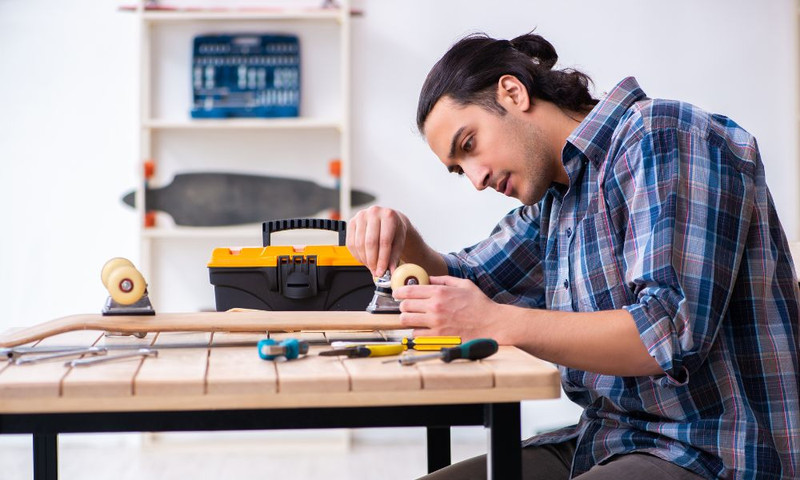To install new bearings on a longboard, remove the old bearings and clean the bearing seats. Then, press the new bearings into place using a bearing press or the axle of a truck.
Longboarding is an exciting sport that can be enjoyed by people of all ages. To ensure that you are able to get the maximum performance and longevity out of your longboard, it is important to regularly maintain and replace its various components. One of the most vital components in a longboard is its bearings. Bearings are what allow your longboard wheels to spin smoothly and efficiently. Over time, bearings can wear out and require replacement. Installing new bearings on your longboard is a relatively simple process that can be done with a few basic tools. In the following sections, we will discuss step-by-step how to install new bearings on a longboard, so that you can get back to shredding in no time!

Credit: stokedrideshop.com
Understanding Bearings And Components
If you’re an avid longboarder or someone who’s just starting to gain an interest in it, you should know how to properly maintain your board. One of the essential components of a longboard that requires replacement is the bearings. When bearings wear out, they can cause your ride to become rough and noisy, which can affect your overall performance.
To ensure you have a smooth and enjoyable ride, it’s essential to understand bearings and their components.
Types Of Bearings Available In The Market
Before purchasing new bearings, you need to know the types currently available in the market.
- Steel bearings: these are the most commonly used bearings with an affordable price point but may require frequent cleaning and lubrication to prevent rust from forming.
- Ceramic bearings: these are more high-end bearings that are durable, lightweight and offer a smoother ride. They are more expensive than steel bearings but require less maintenance.
- Hybrid bearings: these combine the advantages of both ceramic and steel bearings and provide a balance of performance and durability.
Identifying The Different Components Of A Bearing
To install new bearings correctly, you need to learn the different components of a bearing.
- The outer ring: this covers the entire bearing and is usually made of durable materials such as steel or ceramic.
- The inner ring: this is the part of the bearing that houses the balls or rollers and is responsible for keeping them in place.
- The retainer: this is also known as the cage, and its role is to keep the balls or rollers evenly spaced as they rotate.
- The balls or rollers: these are the primary components that enable the bearing to move and rotate smoothly.
Choosing The Right Bearings And Components For Your Longboard
Choosing the right bearings and components for your longboard can be challenging, especially with so many options available.
- Riding style: choose bearings that match your riding style. For instance, if you prefer cruising at high speeds, you may want to consider ceramic bearings as they can withstand high speeds.
- Budget: be sure to choose bearings that fit your budget. Remember that expensive bearings may not always be the best fit for your longboard.
- Brand reputation: do your research to determine which brands are reputable in the market. Also, choose components that match the brand of your longboard.
- Bearing rating: check the bearing’s rating to understand its level of durability and performance.
By understanding the different types of bearings, their components, and tips for choosing the right bearings and components, you are in a better position to make an informed decision when purchasing new bearings for your longboard. Proper maintenance of your longboard will not only ensure that it lasts longer but also improve your overall riding experience.
Pre-Installation Preparation
Installing new bearings on your longboard can be a challenging yet rewarding task, especially if you’re an avid rider. However, to ensure your longboard wheels roll smoothly and reliably, it is crucial to take your time during the pre-installation preparation process to get everything ready.
This includes examining your longboard’s wheels and bearings, proper cleaning and lubrication, and having the necessary tools and materials at hand.
Tools And Materials Required For The Installation Process
Before you begin, make sure you have the following tools and materials to get started:
- A longboard bearing press or a skateboard truck axle
- Bones speed cream or any bearing lubricant of your choice
- A small bowl or plastic container
- A cleaning solvent (isopropyl alcohol, acetone, or citrus cleaner)
- Paper towels or clean rags
- A flathead screwdriver or a precision tool
- Rubber gloves (optional)
Examining Your Longboard’S Wheels And Bearings
Before you replace your bearings with new ones, inspect your wheels and bearings closely to identify any signs of damage, wear, or debris.
- Check your wheels for flat spots, chips, or scratches. If you see any, replace your wheels before installing new bearings.
- Remove your bearings from the wheels and examine them for signs of rust, dirt, or binding.
- Test the bearings by spinning them with your fingers. If they don’t spin freely or make odd noises, they may be worn out or damaged.
- If your bearings are excessively dirty or rusted, consider cleaning them before installing new ones.
Properly Cleaning And Lubricating The Bearings
Proper cleaning and lubrication are crucial steps in preparing your bearings for installation.
- Remove the shields or covers from your bearings using a precision tool or flathead screwdriver.
- Place your bearings in a small bowl or container with a cleaning solvent of your choice. Swirl the container for a few minutes to loosen any dirt or debris.
- Remove the bearings from the cleaning solvent and dry them thoroughly with paper towels or clean rags.
- Apply a small amount of bearing lubricant to each bearing and reassemble the shields or covers.
- Repeat this process for all bearings.
With these simple yet necessary steps, you’ll have your longboard bearings ready for installation in no time.
How to change skateboard bearings and wheels EASILY
Step-By-Step Installation Process
Longboarding is an enjoyable physical activity that requires good equipment maintenance to keep the ride smooth and safe. One of the most critical components of a longboard is the bearings. Over time, bearings may wear out and need to be replaced.
In this article, we’ll explain the step-by-step installation process on how to replace your old bearings with new ones. Following these guidelines can help maintain your longboard’s performance and extend its lifespan.
Removing The Old Bearings From The Wheels
The first step in installing new bearings is to remove the old ones.
- Use a skate tool to remove the axle nuts and washers.
- Insert the axle into the bearing and push down on the wheel to release the bearing from the wheel.
- Once the bearing is out, turn the wheel over, and repeat the process to remove the bearing from the other side.
Preparing The New Bearings
Before installing new bearings, it is essential to ensure they are clean and free of debris.
- Wipe down each bearing with a soft cloth to remove any debris or dirt.
- Apply a thin layer of lubricant to each bearing to ensure smooth performance.
Installing The New Bearings Onto The Wheels
Now that the new bearings are ready to install, here’s how to fit them into the wheels:
- Hold the wheel perpendicular to the ground and place the bearing into the wheel’s center hole.
- Gently press down on the bearing until you feel it snap into place.
- Install the second bearing on the other side of the wheel using the same process.
- Repeat steps 1-3 for each wheel.
Applying Proper Pressure During Installation
When installing the new bearings, it is crucial to apply the proper pressure to avoid damaging them.
- Line up the bearings evenly and apply equal pressure to both sides of the bearing
- Avoid hitting the bearings with a hammer or a hard object as this can cause damage.
- Make sure that the bearings are fully seated and aligned to the wheel space.
Replacing old bearings with new ones can be a simple process by following a few steps, ensuring that your longboard remains in top shape. By following these step-by-step installation processes and taking care of them, you can enjoy a smooth, safe ride and extend the lifespan of your longboard.
Testing And Troubleshooting
If you’re looking to give your longboard a new lease of life, installing new bearings is an essential task. Not only does it allow for smoother rides, but it also prolongs the longevity of your longboard. However, just like any other installation process, some issues may arise during or after the installation.
In this section, we’ll discuss testing and troubleshooting tips to ensure that your new bearings are working correctly and efficiently.
Testing The New Bearings For Proper Functionality
Testing your bearings after installation is crucial to ensure they’re working correctly.
- Set your longboard wheels on a flat surface and spin them. If the wheels don’t spin freely, it may indicate a problem with the bearings.
- Push the longboard to move it forward slowly. Pay attention to any odd noises or friction. If you hear unusual sounds or there’s too much friction, you may need to re-install the bearings.
- Ride the longboard to test the bearing’s functionality. If the board feels shaky or unstable, it may signify an issue with the bearings.
Common Issues That May Occur During Installation
Installing new bearings isn’t always a straightforward process, and some problems may arise.
- Difficulty removing old bearings.
- Bearings don’t align correctly with the wheel or truck.
- Cross-threaded axle nuts, preventing the wheels from spinning.
- Bearings are installed too tightly, causing friction and noise.
Troubleshooting Techniques To Fix Any Issues
If you encounter any of the issues mentioned above, don’t panic.
- Use a bearing removal tool to remove old bearings.
- Ensure that the bearings are correctly aligned with the wheel or truck.
- Use a thread tap to fixes cross-threaded axle nuts.
- Loosen the bearings and re-install them correctly.
Testing and troubleshooting your new bearings is a critical step in ensuring a smooth and safe longboard ride. By following the tips outlined above and conducting regular maintenance checks, your longboarding experiences will be much more enjoyable.
Conclusion
Changing bearings is a simple task that can enhance your longboarding experience significantly. It is crucial to make sure you have the proper tools and take the necessary safety precautions before diving in. Remember to remove old bearings carefully and clean them thoroughly before inserting the new ones.
With a little bit of patience and practice, you will be able to replace your longboard’s bearings swiftly and efficiently. Furthermore, choosing the suitable bearings for your riding style and preferences can make a world of difference in the performance and durability of your longboard.
Stay safe, have fun, and happy riding!



